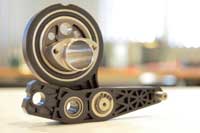
Posted to News on 27th Apr 2013, 00:00
Tailored bearing solutions
When a standard bearing doesn't give you the performance, reliability or functional benefits you need, what's the alternative?

>The ball bearing is one of the most common machine components, so it's no wonder that standardisation has arisen, with a multitude of companies offering catalogues full of standard products. But for the machine builder, a standard com-ponent won't always provide the required functionality. Specially optimised components are required.
>This is where companies such as Jesa come in. Swiss manufacturer Jesa specialises in the design, industrialisation and production of components or sub-assemblies intended to provide a rotation function, with the company producing metal products, engineering polymers and hybrids. The products are used in a wide range of markets, including automotive, industrial, medical, consumer goods and construction.
>A good example of solving specific industrial problems is the recent design of an eccentric unit at the heart of an industrial embroidery machine. The replacement of an entirely metal product with a plastic-metal hybrid not only reduced costs - savings that could be passed on to buyers of the machine - but also increased performance. The new hybrid components weighed less than metal parts, enabling the system to operate at higher speeds, while generating less vibration and noise thanks to the excellent absorption capabilities of the plastic parts.
>Another example of added value is the cam roller used in circuit breakers. Its axis is so applied that it was necessary to use several digital simulations to optimise the design. In addition, a high performance steel combined with a special double heat treatment was necessary. The customer's benefit? A customised product that replaces the standard roller and the high roller loads with a universal roller and all this for the price of the standard version.
>When Jesa talks about innovation, it's not necessarily about putting bearings in an F1 car or about inventing a new polymer. Instead, innovation can mean finding the ideal form of a lip seal, or finding the best combination of materials for occasional dry running, or developing an outer ring geometry that ensures the optimum fit for the plastic overmoulding, or reducing the number of parts in an electric motor running at 110,000rpm. In short, the real innovation is the one that finds real practical use.








